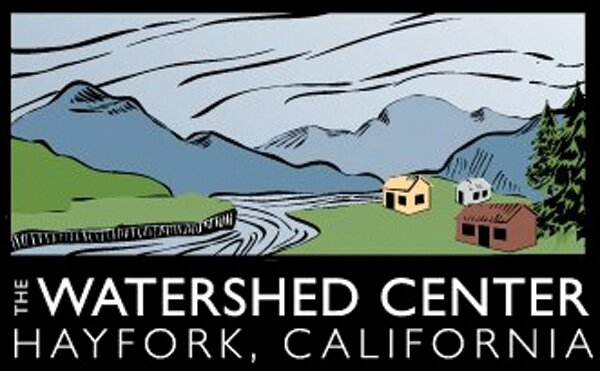Prescribed Burns in June Were Successful for Yellow Star Thistle Reduction
On June 11th, 12th, and 13th 2024, the Watershed Center led prescribed burns in the Hayfork Valley in an effort to reduce yellow starthistle (Centaurea solstitialis, YST) populations. The Trinity Integrated Fire Management Partnership came together to implement these burns, and partners included Hayfork and Hyampom Volunteer Fire Departments, Natural Resource Conservation District, Trinity Resource Conservation District, CAL FIRE, and multiple community volunteers, as well as outside partners from Big Chico Creek Ecological Reserve, Butte County Resource Conservation District / Butte Prescribed Burn Association, and Oregon State University Extension Service.
Smoke rises from a meadow where prescribed fire scorch kills Yellow Star Thistle. Photo Credit: Chad Manley.
As the opening paragraph suggests, this effort was made possible with support from numerous people representing a multitude of organizations from the state and local level. Our fire program truly represents an “all hands all lands” cooperative approach to burning, and we wouldn’t be able to burn without all of these partners coming together to prioritize prescribed fire when the burn windows align with objectives (which often coincides with very short notice).
During these three prescribed burn days, we were able to treat 72 acres throughout the Hayfork Valley currently infested with YST. YST is rated as “high” in the California Invasive Plant Council (Cal-IPC) rating system. Invasive species rated “high” are “species that have severe ecological impacts on physical processes, plant and animal communities, and vegetation structure. Their reproductive biology and other attributes are conducive to moderate to high rates of dispersal and establishment. Most are widely distributed ecologically.” In peak wildfire season, YST also poses a high fire risk, as the cured plant is extremely flammable.
Closeup of Yellow Star Thistle depicting its yellow flower and spiny barbs. YST must be burned before these yellow flowers appear. If YST is burned after the yellow flower has appeared, the seed is viable, and the YST will overtake the burned area with seed and be much more abundant the following year.
The ideal time to burn YST is after the plant has bolted but before any yellow flowers have appeared. This time frame usually occurs in June. The goal is to scorch-kill the plant with heat from the fire, rather than consume it, since the plant is not available to burn during this window. If YST is burned after the yellow flower has appeared, the seed is viable, and the YST will overtake the burned area with seed and be much more abundant the following year. Our Fire Effects Monitors noted that although the YST plants were still standing after the burns, the pale green stems turned a light, silvery-gray, indicating that the heat from the flames killed the plants through scorching.
By revisiting and reburning the same areas up to three consecutive years for highly infested areas, the seedbank and YST population will be reduced by up to 95%. Our fire team has also seen 95%+ reduction with just one properly timed June burn in low infestation areas, such as oak woodlands, where YST populations are more sporadic.
June can be a hot and dry month in Trinity County. The Watershed Center has been deeply ingrained in the community for over 30 years and we listen to locals, so we know there is past trauma and fear within the Trinity County community from intense wildfire seasons and the Lowden Prescribed Fire escape in July of 1999. Our team is very familiar with the Lowden Prescribed Fire review and we implement the lessons learned from that event into our burns. We take fire behavior and weather forecasts into account, have adequate resources for the complexity of the burns, formulate contingency plans, understand the local diurnal wind patterns, and follow our reviewed and approved burn plans.
Only fine fuels were targeted for burning during this window. An unscathed shrub is surrounded by good black char. Photo Credit: Thena Tak.
Our Fire Management Team goes through extensive planning and preparation for these burns. We have air quality permits from the North Coast Unified Air Quality Management District and CAL FIRE permits in place when we burn. We continually communicate with forecasters at the National Weather Service and make day-of “Go No-Go” decisions based on weather conditions, resources, external factors, and test fire results.
We are grateful for the support we’ve received from local communities and recognize that trust is built and maintained over time. By building upon past lessons learned, staying in frequent communication with impacted populations, and making risk management decisions that consider wind, fuel conditions, and resources, we hope to continue burning each June to reduce YST populations, as weather windows allow, while bringing more residents and community members into the fire family of Trinity County.
Large burns require cooperation amongst many people. We are grateful for the partnerships that make prescribed fire possible in Trinity County. Photo Credit: Thena Tak.
The Watershed Center Fire Team believes that “fire is for everyone”, regardless of land ownership status, age, physical ability, or experience. There is a way for everyone to contribute to safe, effective prescribed fires. If you are interested in participating on a burn with the Watershed Center team, please reach out to Ellen and Qwalen at fireoperations@thewatershedcenter.com. To learn more about WRTC’s fire management team, visit their website https://www.thewatershedcenter.com/prescribed-fire-programs, and meet the WRTC Fire Team here https://www.thewatershedcenter.com/meet-the-wrtc-fire-team.




